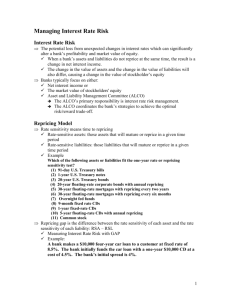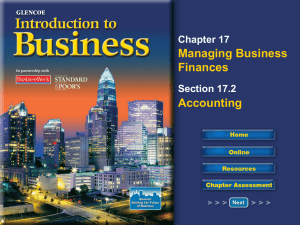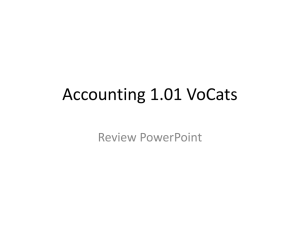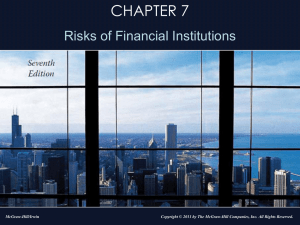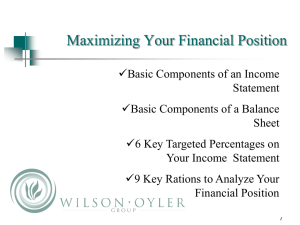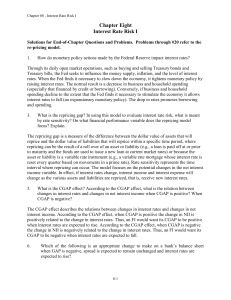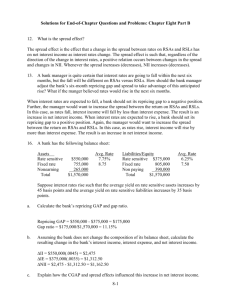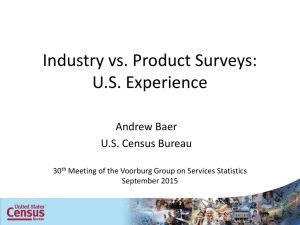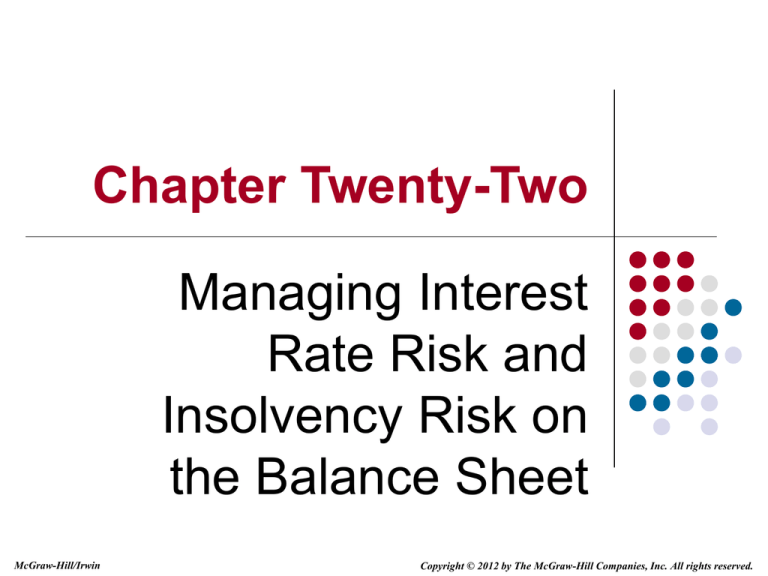
Chapter Twenty-Two
Managing Interest
Rate Risk and
Insolvency Risk on
the Balance Sheet
McGraw-Hill/Irwin
Copyright © 2012 by The McGraw-Hill Companies, Inc. All rights reserved.
Interest Rate Risk
The asset transformation function performed by
financial institutions (FIs) often exposes them to
interest rate risk
FIs use two main methods to measure interest rate
exposure:
The repricing model (a.k.a. the funding gap model)
examines the impact of interest rate changes on net
interest income (NII)
The duration model examines the impact of interest rate
changes on the overall market value of an FI and thus
ultimately on net worth
22-2
Interest Rate Risk
The Federal Reserve’s monetary policy is the most
direct influence on the level and movement of shortterm interest rates
Changes in the Federal Reserve’s target fed funds
rate affect all interest rates throughout the economy
Expansionary monetary policy involves
decreases in the target fed funds rate
Contractionary monetary policy involves
increases in the target fed funds rate
22-3
The Repricing Model
The repricing or funding gap is the
difference between those assets whose
interest rates will be repriced or changed over
some future period and liabilities whose
interest rates will be repriced or changed over
some future period
Account characteristic
Within the
planning period
Beyond the
planning period
Accounts that mature
Rate Sensitive
Fixed Rate
Except that variable rate
accounts with a rate reset
Rate Sensitive
Fixed Rate
22-4
The Repricing Model
Quarterly reporting of commercial bank assets
and liabilities is detailed by maturity bucket (or
bin):
One day
More than one day to 3 months
More than 3 months to 6 months
More than 6 months to 12 months
More than 1 year to 5 years
More than 5 years
22-5
The Repricing Model
The gap in each bucket or bin is measured as the
difference between the rate-sensitive assets (RSAs)
and the rate-sensitive liabilities (RSLs)
Rate-sensitivity measures the time to repricing of an
asset or liability
The cumulative gap (CGAP) is the sum of the
individual maturity bucket gaps
The cumulative gap effect is the relation between
changes in interest rates and changes in net interest
income
22-6
The Repricing Model
The change in net interest income for any given
bucket i (ΔNIIi) is measured as:
ΔNIIi = (GAPi)ΔRi = (RSAi – RSLi)ΔRi
where
GAPi = the dollar size of the gap between the book
value of rate-sensitive assets and rate-sensitive
liabilities in maturity bucket i
ΔRi = the change in the level of interest rates
impacting assets and liabilities in the ith
maturity bucket
22-7
The Repricing Model
A common cumulative gap of interest to commercial
bank managers is the one-year repricing gap
estimate:
1 year
1 year
NII RSAi RSLi Ri
i 1 day
i 1day
where ΔNII is the cumulative change in net interest
income from all rate-sensitive assets and liabilities
that are repriced within a year given a change in
interest rates ΔRi
22-8
The Repricing Model
The spread effect is the effect that a change
in the spread between rates on RSAs and
RSLs has on net interest income as interest
rates change
ΔNIIi = (RSAi x ΔRRSA) – (RSLi x ΔRRSL)
22-9
The Repricing Model
Dollar GAP
Positive
RSA > RSL
Spread Effect
Positive
Negative
Positive
Negative
R
Increase
Increase
Decrease
Decrease
Direction of NII
Increase
Ambiguous
Ambiguous
Decrease
Negative
RSA < RSL
Positive
Negative
Positive
Negative
Increase
Increase
Decrease
Decrease
Ambiguous
Decrease
Increase
Ambiguous
Ignoring the spread effect for simplicity (highlighted rows):
For a positive repricing gap, interest rates and profitability
move in the same direction
For a negative repricing gap, interest rates and profitability
move in the opposite direction
22-10
The Repricing Model
The repricing model has some major weaknesses
The repricing model (RPM) measures only shortterm profit changes, not shareholder wealth
changes
The maturity buckets are arbitrarily chosen
All assets and liabilities that mature within the
maturity bucket are considered equally ratesensitive; this is defacto, not true if a spread
effect exists
22-11
The Repricing Model
The repricing model has some major weaknesses
The RPM ignores runoffs
Runoffs are receipts of cash on FRA or
payments due on FRLs that occur during the
maturity bucket period. This cash must be
reinvested by the intermediary and it is rate
sensitive
The RPM ignores prepayments
The RPM ignores cash flows generated from offbalance-sheet activities
22-12
The Duration Model
Duration measures the interest rate sensitivity of an
asset or liability’s value to small changes in interest
rates
% in the market val ue of a security
D
R /(1 R)
The duration gap is a measure of overall interest rate
risk exposure for an FI
To find the duration of the total portfolio of assets (DA)
(or liabilities (DL)) for an FI
First determine the duration of each asset (or liability)
in the portfolio
Then calculate the market value weighted average of
the duration of the assets (or liabilities) in the portfolio
22-13
The Duration Model
22-14
The Duration Model
The change in the market value of the asset portfolio for
a change in interest rates is:
R
A A ( DA )
(1 R )
Similarly, the change in the market value of the liability
portfolio for a change in interest rates is:
R
L L ( DL )
(1 R )
22-15
The Duration Model
Finally, the change in the market value of equity of an FI
given a change in interest rates is determined from the
basic balance sheet equation:
A L E A L E
By substituting and rearranging, the change in net worth
is given as:
R
E ( DA kDL ) A
(1 R)
where k is L/A = a measure of the FI’s leverage
22-16
The Duration Model
The effect of interest rate changes on the market value
of equity or net worth of an FI breaks down to three
effects:
The leverage adjusted duration gap = (DA – kDL)
measured in years
reflects the duration mismatch on an FI’s balance sheet
the larger the gap, the more exposed the FI to interest
rate risk
The size of the FI
The size of the interest rate shock
22-17
Duration Gap Example
Assets
T-bills
T-notes
T-bonds
Loans
$ Amount Weight Duration Weight x Duration
90 2.96%
0.500
0.015
55 1.81%
0.900
0.016
176 5.78%
4.393
0.254
2,724 89.46%
3.000
2.684
3,045 100.00%
DurA
2.969
Liabilities & Equity
Deposits
Federal funds
Borrowings
Equity
k
Duration Gap
R
R
E
$ Amount
2,092
102
536
315
3,045
72.05%
DurA - kDurL
12%
0.005
2.023 3,045
0.005
1.12
Weight Duration Weight x Duration
68.70%
0.500
0.344
3.35%
0.010
0.000
17.60%
5.500
0.968
10.34%
0.000
100.00%
DurL
1.312
2.023
ΔE DurA kDurL A
ΔR
(1 R)
-$27.51
22-18
The Duration Model
Difficulties emerge when applying the duration model to
real-world FI balance sheets
Duration matching (immunization) can be costly as restructuring
the balance sheet is time consuming, costly, and generally not
desirable
Immunization is a dynamic problem
Duration of assets and liabilities change as they approach
maturity
The rate at which the duration of assets and liabilities change
may not be the same
Duration is not accurate for large interest rate changes unless
convexity is modeled into the measure
Convexity is the degree of curvature of the price-yield curve
around some interest rate level
22-19
Duration and Convexity
(Curvature)
22-20
Insolvency Risk
To ensure survival, an FI manager must protect against
the risk of insolvency
The primary protection against the risk of insolvency is
equity capital
Capital is a source of funds
Capital is a necessary requirement for growth under
existing minimum capital-to-asset ratios set by regulators
Managers prefer low levels of capital in order to
generate higher return on equity (ROE)
The moral hazard problem exacerbates this tendency
The result is an increased likelihood of insolvency
22-21
Insolvency Risk
The Capital Purchase Program (CPP) was part of the
TARP funding in 2008-2009
The Treasury purchased over $200 billion of senior
preferred equity under the program
The CPP was designed to help FIs increase their capital
with the aim of increasing lending to the general public
Lending fell in 2008, 2009, and 2010, so in this
sense, the program was a failure, although
presumably lending would have fallen even farther
without it and more failures may have occurred
22-22
Insolvency Risk
The economic meaning of capital is net worth
Net worth is equal to the difference between the
market value (MV) of an FI’s assets and the
market value of its liabilities
The market value or mark-to-market value
basis uses balance sheet values that reflect
current rather than historical prices
Regulatory and accounting-defined capital is
based in whole or in part on historical or book
values (BV)
22-23
Insolvency Risk
The market value of capital and credit risk
Decreases in current and expected future cash flows on loans
lowers the MV of an FI’s assets
Decreases in the MVs of assets are directly charged against the
equity owners’ capital or net worth
Liability holders are only hurt when asset losses exceed equity
capital levels
Thus, equity capital acts as “insurance” protecting liability
holders (and guarantors such as the FDIC) against insolvency
risk
The market value of capital and interest rate risk
Rising interest rates decrease the value of an FI’s assets more
than the value of the FI’s liabilities when the duration gap of the
FI’s balance sheet is positive
Losses are first charged against equity capital
22-24
Interest Rate Changes and
Equity Value
Duration Gap
Positive
Negative
Interest Rate
Change
Increase
Decrease
Biggest Value
Change
Assets
Assets
Equity
Value
Decreases
Increases
Increase
Decrease
Liabilities
Liabilities
Increases
Decreases
22-25
Insolvency Risk
The book value of equity capital is the difference
between the BV of assets and the BV of liabilities
BV of equity is usually composed of the par value of equity
shares, the surplus value of equity shares, and retained
earnings
BV of equity does not equal the market value of equity
Managers can manipulate the BV of equity by:
Using discretion when timing the recognition of loan losses
Selectively selling assets to inflate reported earnings (and
thus capital)
22-26
Insolvency Risk
Interest rate changes have no impact on book values of
assets and liabilities
FIs can be solvent from a BV perspective, but
massively insolvent from an economic perspective
The degree to which the BV of equity deviates from the
MV of equity depends on:
Interest rate volatility
Examination and enforcement
Loan trading
The discrepancy between the MV and BV of equity is
measured by the market-to-book ratio
22-27
Market-to-Book Ratios
22-28
Insolvency Risk
Arguments against using market value
accounting include:
It is difficult to implement
especially for small FIs that are not publicly traded
It introduces variability into reported earnings
FIs claim they may be less willing to accept
longer-term asset exposures if they must be
continually marked-to-market
22-29
Insolvency Risk
The industry argues the lack of liquidity in the recent crisis
led to unrealistically low market values of assets and
marking to market imposed excessive losses on
institutions
Consequently, the Financial Accounting Standards
Board (FASB) allows management to rely on internal
estimates of cash flows to estimate fair value
As of April 2009, FASB allows DIs to not recognize losses
in earnings and regulatory capital on accounts that are a)
designated as held for investment rather than sale and b)
temporarily impaired in value due to market conditions
rather than underlying credit deterioration
22-30




